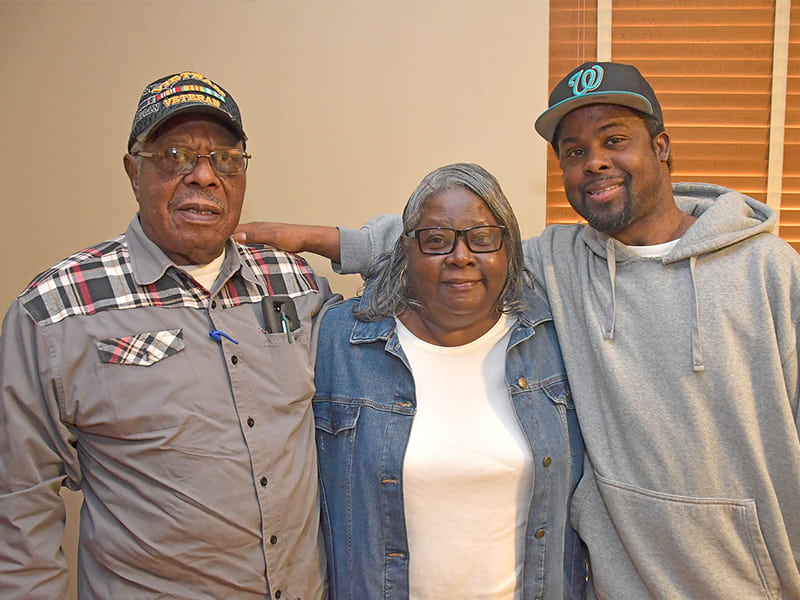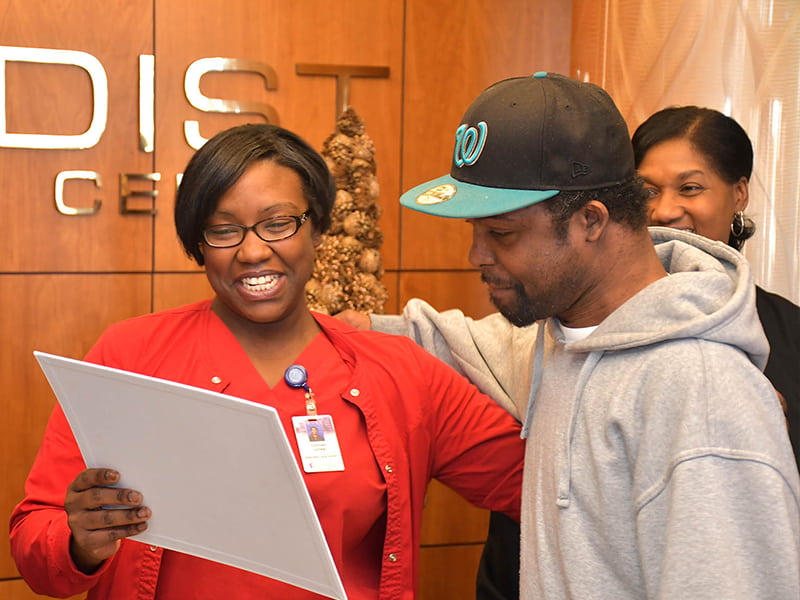Patient’s mysterious neurological disease no match for UMMC specialist

Michael Jordan of Greenwood was never supposed to make it home for the holidays.
Tethered to a ventilator six months ago and unable to walk due to a baffling neurological condition, the 40-year-old seemed destined to live out his life at Methodist Specialty Care Center in Flowood. But thanks to a University of Mississippi Medical Center physician whose sleuthing led to a diagnosis, and the meticulous care of his MSCC team, Jordan was home for Christmas on his own two feet.
After months of being on a feeding tube at MSCC, a part of Methodist Rehabilitation Center in Jackson, Jordan is finally able to enjoy his mom’s cooking. “I love her lasagna,” he said. “She makes it from scratch, and it’s super good.”
Dr. Saurabh Shukla, UMMC assistant professor of neurology, has a passion for solving medical puzzles. He put the pieces together for Jordan, whose mysterious decline began about two years ago with a crippling fatigue. Jordan slowly lost the ability to breathe and swallow on his own. That led to ICU care for about 10 months between UMMC and Greenwood-Leflore Hospital prior to his care at MSCC.
“When he first came to see me, he was so sick,” Shukla recalled as he examined Jordan Jan.22 on a follow-up appointment. “I was excited, though, because I knew it was treatable.”
“I just got weaker and weaker,” Jordan said. “I’d get up in the morning and walk to the bathroom, then I’d have to sit down for five minutes. Every little thing, I had to take a break.”
He told himself he just needed to stay active and work out. “But I never had the energy” or the strength, he said. “I couldn’t even do one push-up, and I knew something was wrong. But I was scared to go to the doctor.”

His mother, Mary Jordan, finally got him to the Greenwood hospital on Jan. 21, 2019. “They said if I had come in a couple of days later, I would have died,” he said.
“It was panic time, and I had to pray real hard because this might be the end,” Mary Jordan said.
When Jordan’s sickness first started, his mother had been told her son had the heart of an old man. “I thought that was what was weighing him down,” she said. But when tests couldn’t pinpoint the root of Jordan’s problems, he was transferred to UMMC’s intensive care unit.
By mid-March, he was back at Greenwood Leflore with no exact diagnosis. His status was still unchanged in June, so he was moved to MSCC. The residential care facility is designed for the severely disabled, and Jordan knew he needed the center’s expertise even though he couldn’t imagine a future so far from family.
His once-strong muscles had gone on strike, forcing him to rely on a machine to breathe, a wheelchair to move and a feeding tube to eat. “I was depressed and I wanted to give up,” he said. “But the big man above wouldn’t let me give up.”
Neither would the caregivers at MSCC. “They motivated me to keep on fighting the good fight,” he said.

As an affiliate partner with UMMC, Methodist Rehab has access to a variety of specialists at the state’s only academic medical center. MSCC Medical Director Dr. John Wofford was adamant that Jordan keep follow-up appointments at UMMC. “I wanted him to go because it wasn’t clear what he had,” Wofford said.
The UMMC team included Shukla, a newly arrived neurologist. “I’m always on the lookout for something reversible,” Shukla said. “If something is treatable, you don’t want to miss out on that.”
Meeting Jordan for the first time was troubling, Shukla said. “A 40-year-old person with a trach, it’s devastating to see that,” he said. “And the hospital had worked so hard and hadn’t yet found a cause.”
As he combed through Jordan’s extensive medical records, Shukla could see why his case was confusing. There were signs that congestive heart failure might have led to his lung problems. Or that his time in ICU had resulted in critical illness myopathy, a disease of the limb and respiratory muscles characterized by widespread muscle weakness and a failure to wean from mechanical ventilation.
Doctors had also suspected myasthenia gravis (MG), a chronic autoimmune neuromuscular disease that causes weakness in the skeletal muscles. However, lab tests didn’t confirm the most common form of the disease.
According to the National Institutes of Health, the condition primarily affects muscles that control eye and eyelid movement, facial expression, chewing, talking and swallowing. The symptoms didn’t exactly fit Jordan’s experience, but Shukla recognized a pattern he’d seen before.
Jordan’s problems with breathing, swallowing and shoulder weakness reminded Shukla of MuSK myasthenia gravis, MMG for short. It’s a rarer form of MG that impacts about 5 to 8 percent of people with the disease.

“I’ve seen five cases here, and when I was a neuromuscular fellow in Miami and neurology resident at Harvard, I had about 15,” said Shukla, who is board certified in general neurology, neuromuscular medicine and electrodiagnostic medicine.
Sure enough, when Shukla tested for MMG in late July, the results confirmed his hunch. He prescribed steroids and a promising MMG drug called Rituximab, and the effect was dramatic.
Cynthia Thornton, a registered nurse and care coordinator for the UMMC Department of Neurology, is part of the multidisciplinary team that is treating Jordan. She shepherded the process of getting Jordan’s infusions of Rituximab set up at a UMMC clinic located at Select Specialty Hospital in north Jackson.
“He told me the very first treatment, he could feel a change,” Mary Jordan said. “By the second treatment, I saw it in his face. He just started blossoming.”
On Dec. 18, six months after arriving at MSCC in a power wheelchair, Jordan wiggled through a crowd of well-wishers and headed out the door on his own two feet. Jordan and staff members were moved as he returned hugs, handshakes, fist bumps and tremulous smiles.

Thornton still sheds tears of happiness over Jordan’s outcome, even though she hasn’t personally given him front-line care. “Even if it’s just on the phone, I get to talk to him and form a relationship,” she said. “It’s so exciting. He’s done so well.”
Today, Jordan reports no symptoms of the disease and has no problem walking. “This has opened my eyes to a new experience in life,” a grateful Jordan said. “The good man above blessed me with Dr. Shukla.”
Jordan will continue to receive infusions of Rituximab, two doses 15 days apart during a six-month period, for the foreseeable future. “Rarely does this disease become quiet,” he told Jordan. “We don’t want to take you off the medication because of the possible risk that symptoms could come back.”
Dramatic recoveries are rare in places that serve people with quadriplegia, brain injury, ALS and the like.
“We are considered the premier facility in the state for vent-dependent residents,” said Larry McKnight, vice president of long-term care for MRC, which opened MSCC in 2004. “Our staff probably gets more experience on a daily basis with ventilators than a regular nursing home would have in a lifetime.”
“When his legs and arms got strong enough, he was walking down the hall pushing the wheelchair with his ventilator in it. You don’t see that every day,” Wofford said.

MSCC’s team of respiratory therapists took Jordan from ventilator to tracheotomy tube to totally breathing on his own. “He had his prayers and his faith, and we were aggressive with him,” said respiratory therapist Felisha Davis. “To see someone progress like that was amazing.”
Jordan said he believes God has something in store for him, and he’s ready for a new journey. “You can’t take life for granted,” he said. “This taught me to have faith, and to keep my heart full of love and not hatred.”
For patients as ill as Jordan was, “the concern is that they will never get better,” Shukla said.
“Coming back from this is pretty satisfying for the entire team.”


